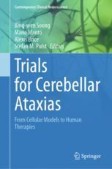Search
Search Results
-
Neuropathology of Ataxias
The neuropathology of major types of cerebellar system degeneration is described in this chapter. Multiple system atrophy (MSA) is a major,...
-
Recent Advances on Therapeutic Approaches for Friedreich’s Ataxia: New Pharmacological Targets, Protein, and Gene Therapy
Friedreich ataxia (FA) is an inherited autosomal recessive neurodegenerative disorder. The most common mutation in FA is caused by a (GAA)n triplet...
-
MR Spectroscopy in Health and Disease
Magnetic resonance spectroscopy (MRS) enables the noninvasive quantification of up to 20 neurochemicals in selected brain regions and has found many...
-
The mechanism of ferroptosis and its related diseases
Ferroptosis, a regulated form of cellular death characterized by the iron-mediated accumulation of lipid peroxides, provides a novel avenue for...

-
An Exploratory Survey on the Care for Ataxic Patients in the American Continents and the Caribbean
Little is known about access of rare disease carriers to health care. To increase this knowledge, the Pan American Hereditary Ataxia Network (PAHAN)...

-
Episodic Ataxia Type 1: Natural History and Effect on Quality of Life
Episodic ataxia type 1 (EA1) is a rare autosomal potassium channelopathy, due to mutations in KCNA1 . Patients have childhood onset of intermittent...

-
Develo** an Instrumented Measure of Upper Limb Function in Friedreich Ataxia
Upper limb function for people with Friedreich ataxia determines capacity to participate in daily activities. Current upper limb measures available...

-
Frequency and Genetic Profile of Compound Heterozygous Friedreich’s Ataxia Patients—the Brazilian Experience
Friedreich ataxia (FRDA) is the most common autosomal recessive ataxia in Caucasian populations. It is caused by a homozygous GAA expansion in the...
-
The Intersection Between Cerebellar Ataxia and Neuropathy: a Proposed Classification and a Diagnostic Approach
Neuropathy is a common associated feature of different types of genetic or sporadic cerebellar ataxias. The pattern of peripheral nerve involvement...

-
ClearSpeechTogether: a Rater Blinded, Single, Controlled Feasibility Study of Speech Intervention for People with Progressive Ataxia
BackgroundProgressive ataxias frequently lead to speech disorders and consequently impact on communication participation and psychosocial wellbeing....

-
Detecting Tandem Repeat Expansions Using Short-Read Sequencing for Clinical Use
Repeat expansion disorders are a unique class of genetic diseases caused by expansions of short tandem repeats. Until recently, these pathogenic...
-
The Essential Role of Epigenetic Modifications in Neurodegenerative Diseases with Dyskinesia
Epigenetics play an essential role in the occurrence and improvement of many diseases. Evidence shows that epigenetic modifications are crucial to...

-
A Review of Ocular Movement Abnormalities in Hereditary Cerebellar Ataxias
Cerebellar ataxias are a wide heterogeneous group of disorders that may present with fine motor deficits as well as gait and balance disturbances...

-
Diagnostic Delay of Hereditary Ataxias in Brazil: the Case of Machado-Joseph Disease
BackgroundSpinocerebellar ataxia type 3/Machado-Joseph disease (SCA3/MJD) is a rare disease with diagnosis offered by the Unified Health System in...

-
Humanized Mice as a Model to Assess the Response of Human Hematopoietic Stem Cells to Irradiation
NOD SCID mice were humanized by transplanting human hematopoietic cells isolated from umbilical cord blood. A dose-dependent death of hematopoietic...
-
Cerebellar Motor Disorders
Many of the clinical manifestations of cerebellar damage were described at the turn of the nineteenth and twentieth centuries by the pioneers of the...
-
Pattern of Cerebellar Atrophy in Friedreich’s Ataxia—Using the SUIT Template
Whole-brain voxel-based morphometry (VBM) studies revealed patterns of patchy atrophy within the cerebellum of Friedreich’s ataxia patients, missing...

-
Phosphodiesterase Inhibitors Revert Axonal Dystrophy in Friedreich’s Ataxia Mouse Model
Friedreich’s ataxia (FRDA) is a neurodegenerative disorder caused by an unstable GAA repeat expansion within intron 1 of the FXN gene and...

-
R-loop and diseases: the cell cycle matters
The cell cycle is a crucial biological process that is involved in cell growth, development, and reproduction. It can be divided into G1, S, G2, and...

-
How to Design a Therapeutic Trial in SCAs
Spinocerebellar ataxias (SCAs) are rare autosomal dominant inherited neurological disorders characterized by progressive cerebellar symptoms. In the...
